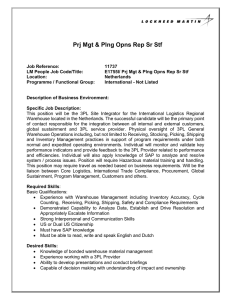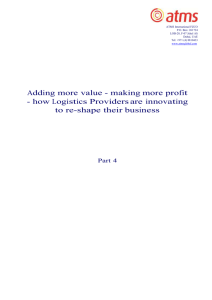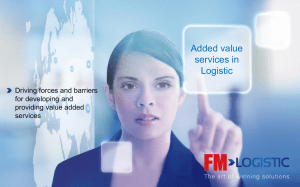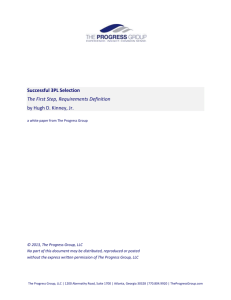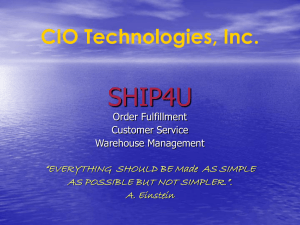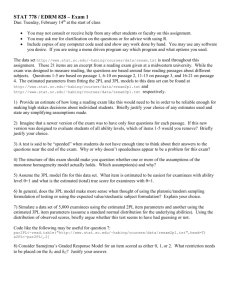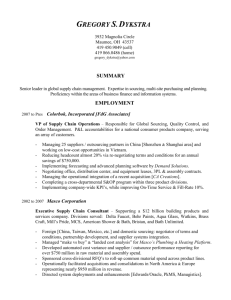Look (Closely) Before You Leap
advertisement
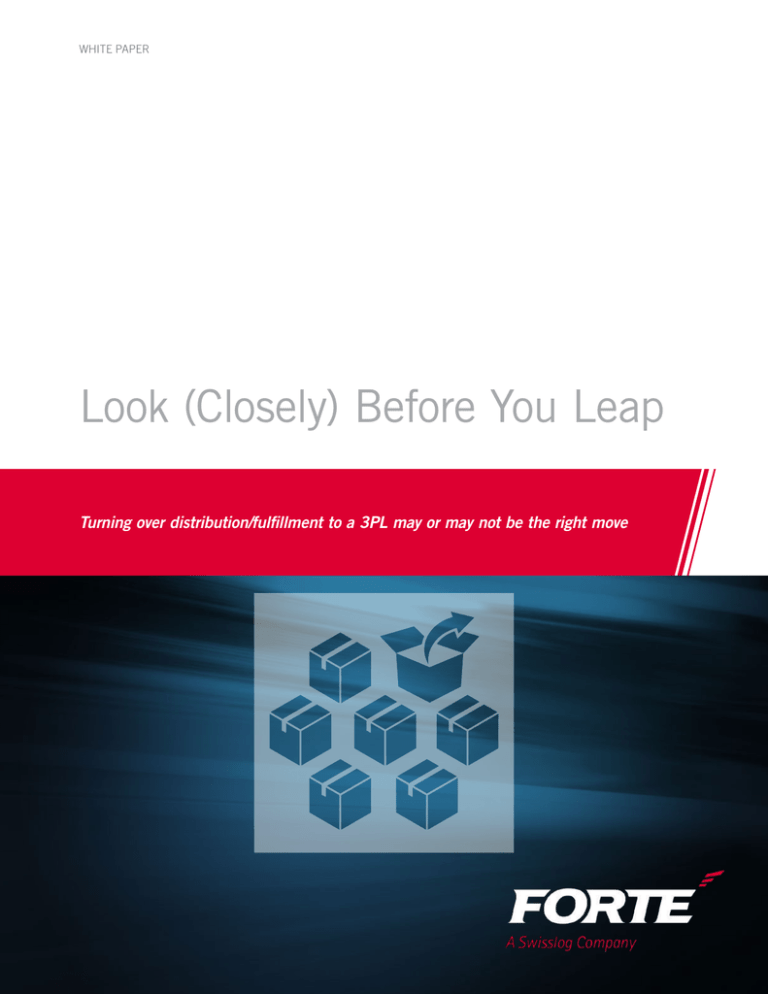
WHITE PAPER Look (Closely) Before You Leap Turning over distribution/fulfillment to a 3PL may or may not be the right move | 2 Look (Closely) Before You Leap Introduction Third-party logistics (3PL) companies have become an important part of today’s supply chain. They have grown as their clients have decided to become leaner, conserve capital and focus on core business strengths and processes. On the other hand, many enterprises view distribution/fulfillment as a strategic tool driving their business models. For them, the supply chain is much more than a transactional process, it is a competitive weapon. And so the question becomes whether to outsource distribution to a 3PL or fulfill from within through a wholly owned distribution center (DC)? There is no simple answer to this conundrum. There are myriad factors to consider and subtle issues to analyze that can be best addressed with the assistance of a deeply experienced supply chain consultant. The Current Environment It may seem cliché, but supply chain management is all about reducing costs and improving the volume and accuracy of throughput while enhancing the customer experience. This is a constant, as true today as it will be tomorrow. But there is a profound complication: Order fulfillment and distribution are increasingly multichannel processes. While largely thought of as a retail phenomenon, a July 2013 study conducted by Peerless Research Group on behalf of Modern Materials Handling magazine, sponsored by FORTE, revealed that manufacturers and distributors are also under pressure to address the challenges of multichannel distribution. Among the key findings of the Peerless Research Group: • About 75 percent of respondents are supporting more than one sales channel, including retail store, telephone call center, catalog fulfillment and Internet sales. • In two years, however, nearly 50 percent of respondents expect mobile e-commerce on smartphones or tablets to be the most important sales tool, followed by traditional e-commerce and internal/field sales personnel. • Approximately 80 percent saw their fulfillment costs go up during the last year, attributed to increased transportation, labor and materials expenses. As we will discuss shortly, labor and associated managerial costs are crucial factors in the 3PL versus in-house fulfillment decision. • Customer expectations are higher than ever. Overnight delivery, free shipping, shipping discounts and even local same-day delivery have become or are becoming standard. • Most respondents are managing all (54 percent) or some (22 percent) of their order fulfillment in-house. Only 13 percent are currently outsourcing all of their order fulfillment. | 3 Look (Closely) Before You Leap These findings jibe with what many supply chain experts have observed over the past several years: Fueled by personal and mobile information technology, multichannel distribution has truly become a disruptive innovation. It has changed the game completely for both B2B and retail enterprises. How a company responds will be of cardinal importance to its very viability. Many industry observers have said the supply chain is the last frontier in creating differentiated customer experiences. If true, the question looms: Do we perform distribution/fulfillment from a captive DC or offload this function to a 3PL? The answer lies in whether your organization assesses fulfillment as a necessary but costly transactional process or a strategically competitive advantage/differentiator driving its business model. When a 3PL Makes Good Business Sense Operating an in-house DC has several advantages. Having complete control over your product and how it is shipped is certainly beneficial. And it can be a significant competitive edge when fully exploited by successfully and consistently performing to or beyond customer expectations. But the periodic investments in fixed costs such as building, material handling equipment (MHE) and management team needed to stay ahead of the pack can be very expensive. Yet these investments, if made wisely, are what enable highly efficient DC operations with a correspondingly low variable cost basis. This is clearly the case when order volumes meet or exceed plans during peak periods. A valid concern with capital investment in the DC is the potential that it becomes a sunk cost, bleeding cash flow during off-peak periods or in an economic downturn. Development of a flexible, scalable DC design and testing its effectiveness under various throughput scenarios will minimize the potential for such an unfavorable condition. Avoiding the need for extensive capital investment is the cardinal advantage offered by a 3PL provider for many companies, providing a variable cost structure based upon cost per order or cost per unit shipped, storage utilization, etc. Paying only for the space, supplies and services used provides a tremendous cost savings opportunity when order volume is extremely unpredictable or subject to dramatic seasonal variation. Moreover, using a 3PL may allow a company to focus more intensely on its core competency/ies, whether that be product innovation, manufacturing expertise, creative marketing, etc. There are several business scenarios in which choosing a 3PL fulfillment partner is both prudent and beneficial. At the top of the list are start-up and stopgap situations. • Start-ups and smaller-sized companies may be inclined to consider or use a 3PL due to one compelling reality: capital deprivation. A young company with limited and precious cash is rightly reluctant to purchase or lease the equipment and take on the payroll to run its own DC. Cash flow is of paramount importance to pay bills and fund growth. Outsourcing, with its pay-as-you-go variable cost structure, can be a better option. • A start-up hits it big, or a more established company is overwhelmed with new multichannel demand. In either scenario, a 3PL provides a stopgap to keep customers satisfied and the company stable until a more permanent solution can be evaluated and implemented. In the case of a company operating its own DC, it may choose to outsource a portion of its business to satisfy demand from an expanded product line or new sales channel while allowing time to expand its existing DC network’s capacities and capabilities. | 4 Look (Closely) Before You Leap • Then there are organizations whose business philosophies may discourage if not preclude asset accumulation in “non-essential” activities, choosing instead to maximize return on investment in their core competencies, such as product design and development, manufacturing or marketing. • Finally, aggressively growing companies may need their capital for research and development or mergers and acquisitions rather than for the funding of DC expansion. In some cases, they may wish to keep these new acquisitions completely separate from their existing operations for managerial control and potential divestiture purposes. Issues Relating to the 3PL Decision Now we turn to the considerations that a company must weigh when deciding between insourcing fulfillment operations or outsourcing them to a 3PL. Hands down, the number one issue is cash flow. Simply put, cash is king. The opportunity cost of money, its net present value and internal rate of return (IRR) calculations, variable versus fixed costs and any other related financial yardsticks trump all other considerations. Veteran industry observers have reached consensus that outsourcing a well-managed fulfillment operation to a 3PL will add about 15 percent to the total cost of their distribution operations. But for start-ups, small and rapidly growing companies and even established but cash-constrained companies, this may be a premium worth paying. The second most important consideration is to assess your company’s ability to attract, hire, retain and develop the managerial talent and staff to professionally operate a fully functioning DC operation. Specifically, is your DC manager creative and resourceful as well as tactically expert in day-to-day processes? Will he seek and be receptive to the advice of consultants for process improvement and software technology? Given a positive response to these questions, it is hard to imagine that a 3PL will provide substantial benefits in cost and service, and outsourcing will almost certainly add operating costs. If there is uncertainty in the answers to these questions, using a 3PL may give you the necessary time to assemble an effective internal management team. But remember, these are the same issues you must address when evaluating the competency of a 3PL’s management staff, as the 3PL DC will only function to the extent that it is effectively managed. The shortage of managerial talent and a qualified workforce are plaguing industries globally. It is a problem that will not be solved easily or soon. Other considerations in deciding to outsource to a 3PL include: • Is your company’s business model changing? Are value-added services (VAS), expedited delivery, multichannel distribution, etc., significantly impacting operations? Additional services provided by a 3PL will add up quickly, and they will be expensive. You will soon discover how elastic these variable costs can be, as they may easily increase your contract costs 25 percent or more. | 5 Look (Closely) Before You Leap • As your business grows, will a purpose-engineered and automated DC operation with customized warehouse control system (WCS) software technology integrated into your company’s warehouse management system (WMS) be a more cost-effective, strategic solution than the predominantly manual-based service of a 3PL provider? • And then there is the delicate, but quite sensitive issue of a unionized workforce. A poor management-union relationship and/or onerous work rules may factor into the 3PL decision to augment or even replace existing in-house DC operations. Caveat Emptor When Selecting a 3PL Before discussing the 3PL selection process, we should at least summarize the conditions that would point to a captive DC — including its upgrade or expansion — as perhaps the better alternative. Generally speaking, these characteristics would favor the DC over a 3PL: • Multiple product lines with a very high number of SKUs • Multiple sales and distribution channels • High fulfillment volume and velocity of unique orders dominated by “each” or “split-case” quantities • VAS and customized packaging that are central to the customer experience and a brand differentiator Contemporary fulfillment processes have evolved to the point where high order accuracy and consistent on-time delivery are the norm. The focus is shifting to more marketing and managerial concerns, including inventory management, e-commerce fulfillment, order customization and — in the dawning of big data — the retrieval and interpretation of electronic data. And still, all of this must be accomplished in the context of reducing costs while increasing throughput and cultivating customer loyalty. Thus, the decision to self-fulfill or outsource is further complicated. There is no easy or foolproof method guaranteeing success in the selection of a 3PL partner. But there is a disciplined process that FORTE has applied with its clients to significantly improve their chances for making an informed decision. It All Comes Down to the RFQ and an Expert Consultant The starting point is an evaluation of your company’s ability to maintain control of distribution activities while enhancing customer service levels and profitability. Document current and projected functional specifications of your operation. These include materials to be handled, storage and transportation requirements, order profiles, necessary throughput, SKU profiles, VAS requirements, customer needs; and delivery scheduling. You must be meticulous about gathering this information, as it will be the basis for constructing your request for quote (RFQ) document. | 6 Look (Closely) Before You Leap Next, estimate the costs of upgrading or expanding current DC operations — construction, MHE, software technology, time and labor requirements, business disruption, etc. — to meet the needs of forecasted distribution initiatives. Then list the benefits of investing in this project and the probability of a timely return on investment (ROI). Coincidental with these activities and, if appropriate, conduct a network analysis to determine the changes in strategy and tactics that will enable you to optimize your supply chain network, given the parameters just discussed. It is unwise to do a cost-benefit analysis and make a decision between carrying out internal improvements and outsourcing your fulfillment until the network analysis creates an optimized model for reference. You are now ready to issue a request for information (RFI) and begin the 3PL selection process. Upfront research will identify as many as a dozen likely candidates based upon their facility location(s), service area(s), menu of services, business partnerships and reputation in the market. Candidates’ responses to the RFI will help you scrutinize their costs, demonstrated results, client references, flexibility/agility, culture, transparency, etc., and enable you to select several primary candidates to be further evaluated. And now we come to the heart of the matter ­— the linchpin for an enduring and successful 3PL relationship or a contentious and calamitous disaster: the RFQ. It is fraught with opportunities for “nuisance” issues to arise. Why? Because the information provided to the 3PL through the RFQ was inaccurate, incomplete, based on assumptions or simply wrong. The RFQ must be granular in detail, in order for the 3PL to provide a pricing structure that won’t need to be renegotiated within the first year of the contract agreement. A couple of examples will illustrate the point. The 3PL is told that it will receive 5,000 cases per day, with the assumption of one SKU per case. In fact, half of those cases contain 10 or more SKUs, requiring considerably more time to break them down and put them away. The 3PL is losing money and must initiate a price adjustment. In another instance, the RFQ failed to state that a certain customer requires special labeling or packing, so this becomes an add-on expense. These so-called “hidden” or “unforeseen” costs add up quickly and cumulatively, often significantly exceeding the expected and budgeted costs. Yet there was no intention to deceive on the part of the 3PL provider. They simply gave you a price for what they knew about the project plus a markup for overhead and margin based upon the information that you provided to them. The RFQ criteria did not communicate a comprehensively detailed picture to allow the 3PL to provide an accurate and good-faith estimate. The relationship quickly becomes awkward, with neither party receiving the expected benefits. There is a way to avoid this unhappy situation. Early on in the process, retain a qualified and experienced supply chain consultant to guide the project. A consultant can provide invaluable service, from problem identification and situational analysis through network optimization research. The consulting team will help evaluate the options between an expansion or reordering of in-house DC operations or outsourcing to a 3PL. And if the latter path is chosen, they will assist with a proven, disciplined methodology, including the construction of a wholly accurate RFQ, to match your firm with the best possible 3PL partner. | 7 Look (Closely) Before You Leap After thoroughly evaluating the candidate providers through the RFQ process, tours of their facilities and meetings with their key management should be conducted along with existing client interviews. Offer reciprocal tours of your facilities and the opportunity to meet your company’s executives. This courtship is necessary to determine cultural and personal compatibility, the quality of their services and account team, their attitude and adaptability to meet your changing needs, etc. It is crucial that your 3PL be a partner fully dedicated, willing and able to meet and exceed your order fulfillment needs and customer service requirements. The Ascendancy of the Captive DC Current research reveals a strong and growing bias toward in-house DC distribution/ fulfillment operations vis-à-vis the services of 3PL providers. Approximately 54 percent of the respondents to a survey conducted in July by Peerless Research Group revealed that they operate their own DC, while 13 percent rely upon a 3PL for all of their order fulfillment needs, a ratio of more than 4:1. Another 22 percent of respondents employ a 3PL only when dictated by unique business conditions. In effect, the decision to self-perform fulfillment versus contracting it out comes down to two key issues: economics and marketing strategy. A captive DC is characterized by high initial capital investment with relatively low long-term variable costs, while the 3PL requires little or no capital expenditure but an operating cost premium of approximately 15 percent, with a variable cost expense approaching 25 percent. From a marketing viewpoint, many companies have come to adopt fulfillment as an integral part of the customer experience, turning it into a key competitive advantage. The table below summarizes the pro and con arguments in deciding between fulfillment through a captive DC or a 3PL provider. 3PL Pros Cons Little/no capital investment Outsourcing to a 3PL can add about 15 percent to total cost of distribution operations Paying only for space, supplies and services used; variable cost structure Variable costs can be elastic and can increase to 25 percent or more Frees resources to focus on core competencies, which do not include distribution as a key strategy Can’t adjust as quickly to exploit market opportunities or provide substantial benefits in cost and service Possible stopgap in times of growth spurts or seasonal peaks Not as responsive to changing market forces Can buy time to formulate a comprehensive marketing strategy and assemble an effective internal management team, design and build DC, etc. 3PL will only function to the extent that it is effectively managed; careful research and contract negotiation are required Investments in fixed costs can lead to higher efficiencies and correspondingly lower variable costs Periodic investments in plant and equipment management/staff development, software technology, etc. Complete control over product, how/when it’s shipped, etc. Relies on skilled management to make quick decisions Nimbleness and flexibility allow maximum customer satisfaction Could turn into sunk cost in off-peak periods or during downturns Ability to automate DC operations can increase responsiveness, efficiency, operating/marketing intelligence, etc. Poor management-union relationship may push distribution to 3PL DC | 8 Look (Closely) Before You Leap Conclusion Faster, better, cheaper is the mantra of contemporary business, including the supply chain industry. But when it comes to distribution/fulfillment operations, is it better to self-perform through captive DC facilities, outsource to a 3PL provider or employ some combination of the two? Do you have enough expertise in-house to conduct the necessary analyses, network optimization studies, etc., to make a professionally informed decision? If not, engage the services of a fully qualified supply chain consultant who will guide and assist you through this process. Further, if a 3PL provider is likely to be at least a part of the solution, select a consultant with deep experience in this area. This consultant will have the requisite analytics and insights, methodology, and framework to select the best possible 3PL firm to meet your organization’s needs. | 9 Look (Closely) Before You Leap Why FORTE Single-Source Accountability Whether we’re helping you develop a strategic plan, design and build a distribution facility or optimize a distribution operation through performance metrics and analytics, FORTE provides a true single point of contact responsible for the complete performance of your distribution network. No finger pointing. No fragmentation of responsibility. No multiple suppliers for technical support. You have performance goals, and it’s our job to make sure they’re met on an ongoing basis. Total Objectivity We don’t manufacture equipment. We don’t develop WMS software. We don’t have commercial arrangements with any suppliers for expected volumes of business. We’re simply interested in delivering the most efficient distribution solutions at the lowest total cost. Our client-side service approach means our only allegiance is to our customers. So with every engagement, you know we’ll choose the most appropriate level and blend of technologies integrated into an effective operational system. Expertise Our team is deeply rooted in the hands-on implementation of DC design and warehouse automation. FORTE’s engineers and technicians integrate today’s best practices in supply chain management and DC operations while developing next-generation technologies. As a result, our solutions employ the best combination of practical advice, data-driven analysis and technology-enabled systems. With FORTE, you get: • More accountability than a consultant • More experience than a systems integrator • More objectivity than a manufacturer 274-WP-1009 MAIN (513) 398.2800 FAX (513) 398.2837 6037 Commerce Court / Mason, Ohio 45040 / FORTE-Industries.com
